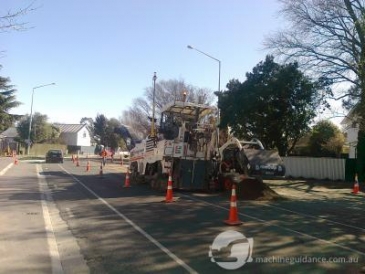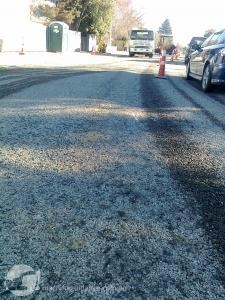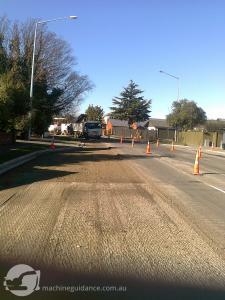New Zealand Earthquake Repairs
The February 2011 Christchurch earthquake caused significant road damage. Key to the reconstruction of these heavily trafficked main arterials was the use of machine control milling technology that ensured an accurate and smooth baseline surface for paving.Published: August 2013
Author: Jeff Winke

Intro
When the February 22, 2011 Christchurch City earthquake erupted, this powerful natural event severely damaged New Zealand's second-largest city and has been described as one of the nation's worst peacetime disasters. To add context, the Canterbury region had been experiencing earthquakes since the September 2010 Darfield event, with over ten thousand recordable earthquakes to date.
One significant road damaged in the quake required the Christchurch City Council's (CCC)'s immediate attention. The heavily trafficked 4.8km long Wairakei Road is an urban two-lane road that got twisted and contorted in the main earthquake. Wairakei Road is about 30km from the epicenter of the 6.3 Richter magnitude earthquake, which was in Lyttleton.
Key to the reconstruction of Wairakei Road was milling the heavily-damaged road to prepare it for resurfacing. Timing was critical since this main arterial needed to be unimpeded in the early morning from 7am to 9am and again from 4pm to 6pm to accommodate Christchurch commuters.
Fulton Hogan, a leading Australasian civil contracting company with 5,000 employees, was engaged by maintenance contractor, City Care, to undertake the road milling and preparation work for asphalt paving. As a leading provider for the CCC, Fulton Hogan understood the importance of their role in the reconstruction of the city.
"Our original thought was to mill the top 30 to 40 millimeters off, but the road had slumped and heaved so much that it would have remained an unacceptable ride when completed," said Tim Clark, Fulton Hogan's Canterbury surfacing manager. "Instead, we proposed the Trimble GCS900 system with Fulton Hogan's milling machines, so that we could mill to a design ensuring a smooth surface for paving."

Two
Fulton Hogan stated that the 3D machine control technology was critical for accommodating the extremely uneven surface in order to quickly return it to the acceptable baseline for resurfacing.
"We knew that traditional milling to design would be prohibitively slow when milling such a surface," says Clark. "We were sure that using Fulton Hogan's milling hardware, teamed with the Trimble 3D control system, would deliver the best possible surface with the least disturbance to the road user and neighbouring residents."
With the help of its local machine control dealer, Fulton Hogan installed the system on its Wirtgen W1200 cold milling machine. Both parties have worked to perfect the system for such a use, and it is now considered, by many, as an integral part of delivering industry-best results.
The Wirtgen W1200 is a 20-tonne, cold-plane, milling machine, manufactured in Germany, which runs on four tracks with independent height control. The ability to control the height at each corner of the machine allows predetermined surface profiles to be produced. This machine is designed to remove a 1200-millimeter wide 300-millimeter deep cut in a single pass.
The Trimble 3D milling system is designed to make it possible to mill surfaces at variable depth and slope without string lines. By controlling the precise cutting depth of the mill, the technology minimizes over-cutting, creates a smoother surface, and reduces the need for additional asphalt in the ensuing resurfacing process.
"Our mandate was to complete the work as accurately and quickly as possible, getting traffic back on the road," Clark says. "The Trimble system helped us cut the construction period in half when compared to using traditional methods. We also saw a reduction of direct cost to the client, and minimized disturbance to stakeholders"
Clark quickly added that another significant benefit of using machine control was it ensured a safer work environment, by reducing the number of staff required to undertake the work with live traffic.

Three
The project site was 120 meters long and approximately 8-9 meters wide, so Clark felt this machine was well-suited for the task.
There was no project design provided, so Fulton Hogan's surveyor Darren Maw arrived early at the site on the first day and using a Trimble SPS930 Universal Total Station was able to capture the site data. Then, using Business Center - HCE from Trimble, he was able to create a digital site plan. Maw said he was able to create the digital design within a few hours, "the project was relatively straight forward from a design perspective, all we really needed was to make sure that the geometry was right as far as the surface, centerline, and where any water would drain. So it was really just a case of picking up the curbs and developing it from there."
Fulton Hogan literally began milling the road by mid-morning and completed it by early afternoon meaning asphalt could be laid the next day.
"The paving contractor was able to use our digital model to determine paving depths," says Clark. "We milled the road to grade achieving a smooth paving surface and allowing a nominal thickness for the entire site. Only existing services fell out of spec, so we painted numbers to provide guidance for the paver team."
The project went very well and was completed in less than two days largely thanks to machine control technologies. "We were able to complete the job quickly, accurately, and with fewer staff because we were using the Trimble system," says Clark.
With the resurfacing completed and traffic flowing, Clark now reflects: "In a very short construction period, under significant pressure we took a severely deformed road surface and milled it to grade using a model which we created. The quality of Fulton Hogan plant, the technology provided by Trimble, teamed with the aptitude of Fulton Hogan's staff resulted in an incredibly smooth ride. We're extremely happy with the results and know that the commuters appreciate it too."
Source Credit
Jeff Winke is a business and construction writer based in Milwaukee, Wis, USA. He can be reached through www.jeffwinke.com.
Return to Articles

